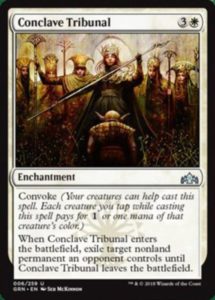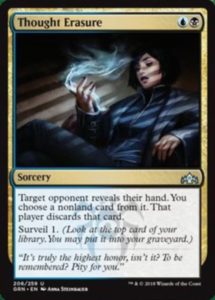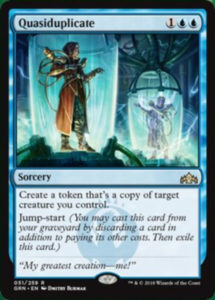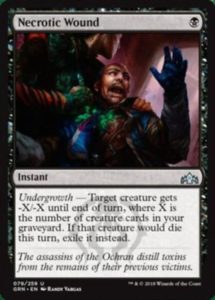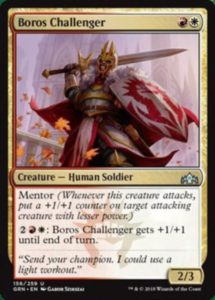Guilds of Ravnica preview season is upon us, and that means we’ve got five mechanics to peruse! Ravnican mechanics don’t have to be as deep as other mechanics, since there have to be a full ten of them (even if they’re not all drafted together) and a lot of the mechanical identity of the guilds is tied up in their colors, rather than their mechanics. Ravnica has featured some of the best-designed mechanics of all time, like Bloodthirst, Convoke, and Extort; as well as some less successful mechanics, like Haunt, Radiance, and Cipher. Today, let’s review all five guild mechanics. There’s a lot to go into, so let’s dive in!
Convoke
Selesnya’s original mechanic returns (after getting new cards in Magic 2015 and being featured in Modern Masters 2015). It’s a clean mechanic that rewards token generation and communicates Selesnya’s ethos of strength through unity. There are a whole bunch of knobs of Convoke—you can have expensive build-arounds like Siege Wurm, potentially free spells like Gather Courage, and fair, slightly overcosted effects that can be discounted, like Conclave Tribunal. Convoke tends to add ~1 mana to a card’s cost. It’s a flexible mechanic, able to go on an any card type (it hasn’t yet been on a Planeswalker, since they don’t have much room for abilities and such innovations are being conserved for the future).
The big question for Guilds of Ravnica is what, if anything, we’ll see Convoke do that it hasn’t done before. It’s been on X spells. It’s been on massive effects, made combat tricks free in three colors, and further rewarded players for having wide boards by providing life and +1/+1 counters. Perhaps we’ll see a card like Jaddi Lifestrider that either rewards you for having tapped creatures, or lets you kick your Convoke spells further by using creatures (à la Kavu Primarch).
Surveil
Surveil is one of two mechanics that is a clear twist on an existing mechanic. It’s basically Scry, but where you throw your unwanted cards in the graveyard, rather than tuck them on the bottom of the library. Most of the time, this distinction is inconsequential—a card in the graveyard is just as inaccessible as the bottom of your library. Sure, you can shuffle your library (which can both undo your work bottoming unwanted cards and allow you a chance to redraw situation-dependant cards) and you can interact with your graveyard, but those are the exceptions, rather than the rules.
Overall, I expect Surveil to be both more powerful than Scry as well as more skill-testing. The graveyard is a powerful resource, and one much more easily abused than the library (particularly when both the Golgari and Izzet mechanics care about the graveyard). For newer players, binning a card feels much more impactful than bottoming one, even though they’re so often the same. I expect players to make mistakes with Surveil more often than they do Scry. It’s for both of these reasons that I don’t expect Surveil to replace Scry as an evergreen keyword anytime soon.
I initially wasn’t much in love with Surveil—it’s obviously a strong mechanic, but it’s only a gentle twist on what we’ve seen before and it’s not the kind of mechanic one would build a deck around. Then I realized that it’s the most Dimir mechanic the guild has ever seen—they’re a guild of ruthless spies. They build up incremental information advantage while assassinating those that stand in their way. Of course they’d have a crueler method of gathering information than everyone else, and of course they’d have a mechanic that would make people underestimate them when compared with all the other more overt guild mechanics. I’m really looking forward to playing with Surveil, if only because I suspect there will be all sorts of sneaky ways to gain advantage with it over Scry.
Jump-start
Just as Amonkhet and Aftermath rotate out of Standard, a new twist on Flashback appears (this time with 100% more Retrace and 0% split card). Jump-Start is Flashback without a costing knob (it always costs the same amount of mana to cast it from your hand or graveyard) and without providing card advantage. Jump-start is a weaker and less flexible take on Flashback, but as seen with Chroma and Devotion, a downgrade is sometimes all a mechanic needs to shine. Unfortunately, one rare card isn’t enough to evaluate the mechanic or visualize what kinds of commons it’ll be on (man, I’d love to see an Inspiration with Jump-start or some Izzet twist on Sanitarium Skeleton), but I’m excited to see the mechanic’s possibilities.
Jump-start is a smart inclusion alongside Surveil and our next focus, Undergrowth. Surveil can “draw” you into Jump-start spells and both it and Jump-start can power up your Undergrowth cards. I don’t think we’ve ever seen guild mechanics play this nicely together before, and that bodes very well for the Limited environment. Ravnican sets are supposed to be about playing two color combinations, but cross-guild synergies mean that an eight person draft pod isn’t always fighting over five archetypes. No Izzet mechanic has ever really played nicely with another guild’s mechanic, so it’s delightful that this one plays nicely with half of the guild mechanics it coexists with.
Undergrowth
Golgari gets its first ability word, and it’s one we’ve seen on several individual cards, from Spider Spawning to Liliana’s Elite to Golgari Grave-Troll to Nemesis of Mortals to Revenant. One card isn’t enough to tell us the scope of how Undergrowth will be used (and as an ability word, it has enormous flexibility as to what it will do). As Golgari proved with Dredge, the graveyard is an incredible resource, and as Spider Spawning proved in Innistrad Limited, a bunch of terrible creatures can do tremendous work if you throw them in the graveyard fast enough.
The biggest concerns I have with Undergrowth as a mechanic are how stocked your graveyard needs to be in order for Undergrowth cards to function and how easy it will be to stock up your graveyard. As a scaling mechanic, Undergrowth has a very high ceiling, but cards like Necrotic Wound also have an incredibly low floor. Compare it to Death’s Approach, which is always on (even if sometimes it does nothing, or only weakens a creature) but checks your opponent’s graveyard (which is much harder for you to reliably fill with creatures than your own tuned deck). Necrotic Wound is further hampered by not being the card type is checks, so every instant and sorcery you put in your deck is taking the place of a creature that could empower their effect (whereas creatures with Undergrowth get a bit better, as do self-milling creatures). In Innistrad, Spider Spawning meant that last-pick creatures had a place (in the graveyard), but the deck functioned only because it was so easy to mill yourself into oblivion. If Undergrowth is going to be a powerful mechanic, it simply can’t require you to have too many creatures in the graveyard—otherwise, it’ll be too hard to use, particularly in Limited.
Necrotic Wound compares interestingly to Nightmare’s Thirst, another recent scaling single black instant that grants -X/-X. Both require a deck built to maximize then, but while Nightmare’s Thirst both turns itself on (guaranteeing that it never has no effect) and is easy to set up in a single turn, once Necrotic Wound is on, it’s basically always on for the rest of the game. It’s much weaker than Ghastly Demise, but that card’s ridiculously good.
And a final note on Undergrowth as a whole—it’s interesting how well it works with Dredge and how poorly it interacts with Scavenge.
Mentor
The newest-looking mechanic on the block, Mentor is here to do what Boros does: encourage attacking. However, instead of just telling you to go wide, the tried-and-true Boros strategy, Mentor has you consider the size of your army. It allows you to take a ragtag bunch of weenies and train them into a disciplined fighting force. It’s the most Night Watch thing I’ve ever seen in Magic and I’m really excited to see how it plays out. Mentor encourages players to play underwhelming creatures (possibly with keywords like flying, lifelink, and double-strike that magnify the value of +1/+1 counters) so that their Mentors provide more power and toughness than their own stats. It’s the Boros take on Evolve, just like Lightning Helix is a Boros spin on a monoblack card.
So, yeah, I’m pretty excited for Mentor. Sure, it’s the kind of mechanic that’s a hard sell for Constructed, unless there’s like a two- or three-mana hasty Mentor with three power (and no, I’m not counting Legion Warboss, whose value is mostly baked into its token production); but it’s a mechanic that can create stories, particularly in Limited. It has a much harder hoop to jump through than Renown and turns off much more easily than does Battalion, but these restrictions and it always functioning the same make it a sleek, streamlined mechanic that puts some Jenny into a color combination that’s classically Spikey and Timmy.
And that’s all five Ravnican mechanics. Hope you enjoyed this dive and here’s looking forward to the whole spoiler season!
And, as always, thanks for reading.
—Zachary Barash
Zachary Barash is a New York City-based game designer. He designs for Kingdom Death: Monster, has a Game Design MFA from the NYU Game Center, and does freelance game design. When the stars align, he streams Magic.
His favorite card of the month is Syndic of Tithes. Sometimes, a simple but powerful mechanic on a simple, but serviceable is all a card needs to shine.

